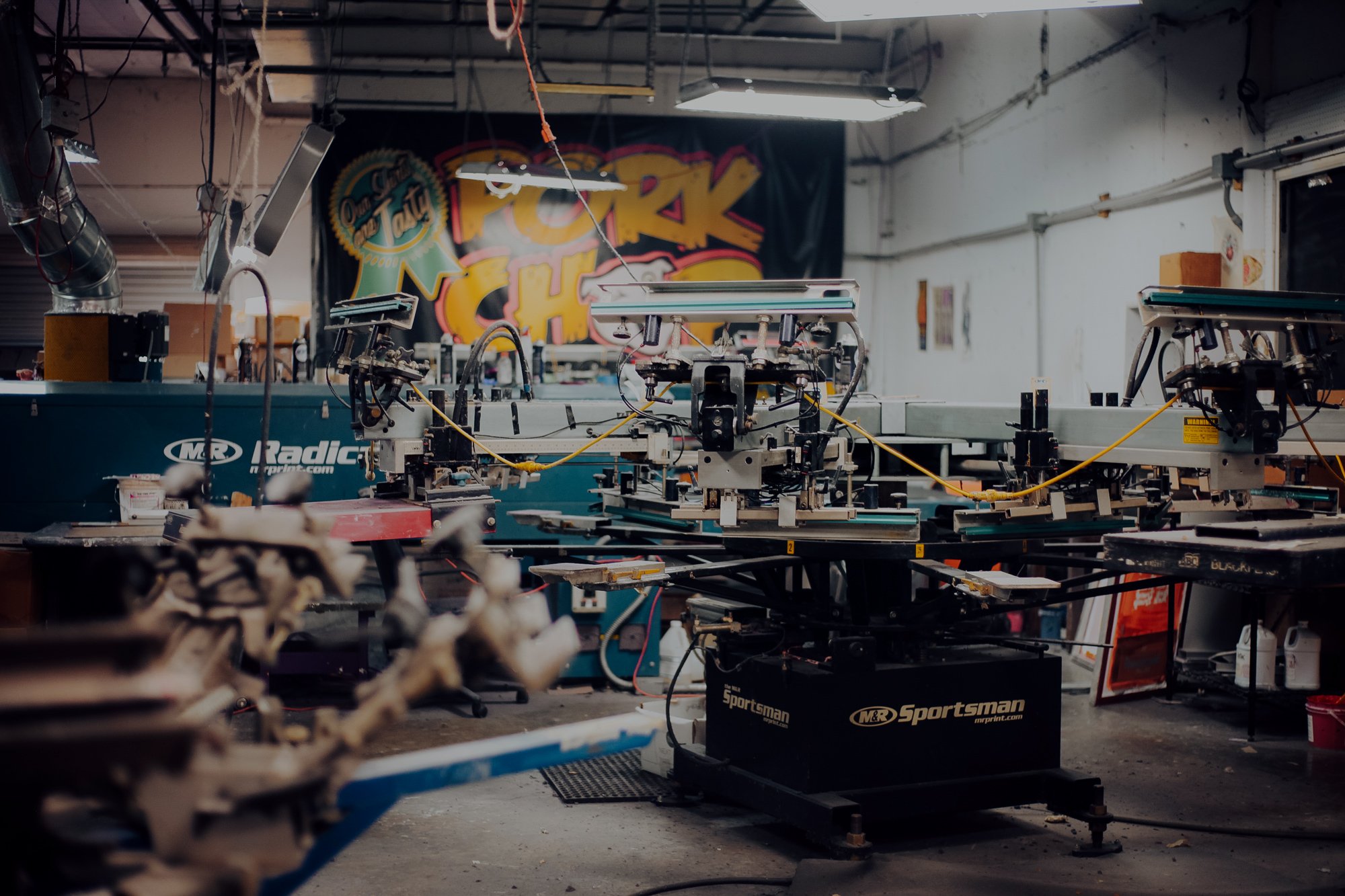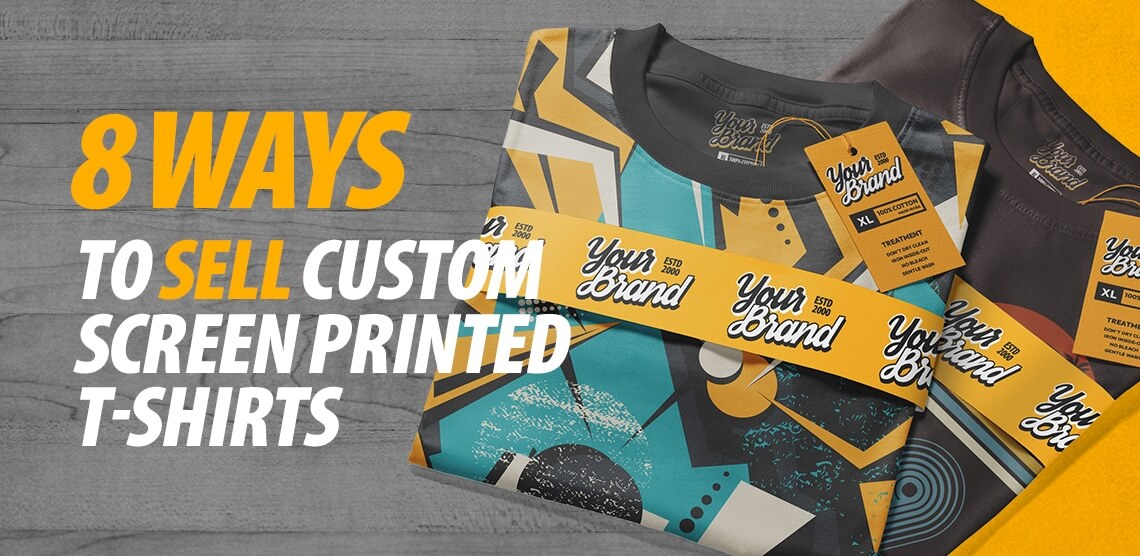Vintage Style Silk Screen Printing for Retro Fashion
Vintage Style Silk Screen Printing for Retro Fashion
Blog Article
Screen Printing Uncovered: Whatever You Need to Understand About T-Shirt and Garment Printing Strategies
If you've ever before asked yourself exactly how those dynamic designs end up on your preferred tees, you're in the ideal location. Screen printing is a fascinating approach that combines art with technique, providing unlimited opportunities for creative thinking. Comprehending the principles, from equipment to ink choices, can considerably affect your outcomes. Prepared to check out the essential aspects that make display printing an art form? Allow's discover the information that can boost your projects.
The Fundamentals of Display Printing: Exactly How It Functions
When you dive right into screen printing, you'll discover it's both an art and a science. At its core, display printing entails creating a stencil, or screen, that permits ink to pass with only in details areas.
Setting the screen over the fabric, after that use a squeegee to press ink through the display onto the garment. Each step is necessary, and grasping them will certainly elevate your screen printing skills, transforming straightforward garments right into special, meaningful items.
Kinds Of Display Printing Methods
As soon as you comprehend the essentials of screen printing, it's time to check out the various strategies that can boost your designs. One preferred method is typical screen printing, where ink is pushed with a stenciled display.
If you're intending for fine details, take into consideration discharge printing. This technique eliminates dye from the fabric, leaving a soft, vintage appearance. An additional choice is plastisol printing, recognized for its resilience and dazzling colors, making it a preferred for many brand names. Experiment with halftone printing to produce gradient impacts and detailed layouts. Each method has its unique charm, so do not hesitate to attempt them bent on discover what fits your design best!
Necessary Tools for Screen Printing
To achieve stunning lead to display printing, having the right tools is fundamental. First, you'll need a durable display printing frame, which holds the mesh that transfers your design onto the garment. Next, buy top quality squeegees; these are necessary for applying ink equally across the screen. You'll additionally require a good exposure system to develop your screens, in addition to a washout booth for cleaning them after use. A reputable warmth resource, like a conveyor clothes dryer or warmth press, is essential for healing your prints to assure durability. Do not fail to remember a correct workspace, equipped with tables and storage space for your materials. Safety gear, such as masks and gloves, will certainly keep you safe from chemicals and inks. With the right tools, you'll be well on your method to generating professional-quality prints.
Choosing the Right Inks and Materials
When picking inks and products for display printing, you need to consider the kind of ink that works finest for your job. Consider material compatibility to guarantee your layouts look terrific and last long. Likewise, discover eco-friendly ink options to make your printing procedure extra sustainable.
Kinds of Screen Inks
Choosing the right screen ink is crucial for achieving vivid, resilient prints that satisfy your job's requirements. There are numerous kinds of display inks to check out. Specialized inks, such as glow-in-the-dark or metallic, can include unique effects to your designs.

Textile Compatibility Factors To Consider
Comprehending material compatibility is vital for attaining premium display prints, especially because various products react uniquely to various inks. Always check your inks on sample fabric to guarantee they stick appropriately and preserve color honesty. In addition, maintain in mind that material weight and structure can affect the final end result, so selecting the appropriate ink and product combination is crucial for your task's success.
Eco-Friendly Ink Options
Environment-friendly inks are coming to be a preferred choice for screen printers that desire to lessen their environmental impact while maintaining top quality. When picking inks, think about water-based inks, which are less harmful and easier to clean up compared to standard solvents. These inks bond well with fabrics, supplying lively outcomes without toxic chemicals. You might additionally check out eco-solvent inks that make use of fewer unstable organic substances (VOCs), making them a more secure choice for both your health and wellness and the world.
Additionally, try to find inks made from renewable energies, such as soy or vegetable-based alternatives. By selecting the best inks and materials, you'll not just produce magnificent layouts yet also add to a more sustainable printing process. Make the switch, and your prints will reflect your commitment to the environment!
Preparing Your Design for Screen Printing

Submit Format Requirements
To ensure your design looks sharp and lively on material, you'll need to pay close focus to submit layout requirements for screen printing. Make sure your layout has a transparent history to stop undesirable white edges on your prints. Keep color modes in mind; CMYK is conventional for screen printing, so transform your RGB designs as necessary.
Color Splitting Up Strategies
Shade splitting up is an important step in preparing your design for screen printing, and grasping it can greatly enhance your print quality. You'll need to break your layout into individual colors, as each color requires a separate screen throughout printing. Beginning by identifying all the shades dig this in your layout and develop layers for each one. You can make use of software application like Adobe Photoshop or Illustrator to separate great post to read and different colors effectively. Be specific to save each layer as a different file, typically in a layout like TIFF or PSD. This accuracy not only assures exact color depiction but likewise improves the printing procedure. By paying attention to shade separation, you'll achieve specialist and vivid outcomes in your screen-printed garments.
Resolution and Dimension
Achieving the most effective lead to screen printing starts with assuring your design has the best resolution and size. Preferably, your art work needs to be at least 300 DPI (dots per inch) for sharp, clear prints. Your last product could look pixelated and unprofessional. if you use lower resolution.
When it concerns dimension, consider the dimensions of your print location. Style your art work to match the last print dimension, ideally producing it in the actual dimensions you'll be publishing. In this manner, you'll avoid any unforeseen scaling issues.
Constantly examine your style in both vector and raster layouts. Vector graphics can be scaled without shedding quality, making them optimal for display printing. Preparing correctly will assure your style looks outstanding on every garment!
Step-by-Step Screen Printing Process
Display printing is a dynamic procedure that allows you to develop lively styles on numerous surfaces. To get going, you'll need a screen, emulsion, and your picked ink. Prepare your screen by cleaning it thoroughly. Next off, use the solution uniformly and let it dry in a dark location. As soon as dry, expose your screen to light with your design positioned on it, which will certainly harden the solution where the light hits, creating a pattern - screen printing kit.
After rinsing the unexposed emulsion, your screen prepares. Establish it up on your printing surface area and align your garment underneath it. Pour ink onto the display and make use of a squeegee to press the ink via the pattern onto the textile. Lift the display very carefully and let the print completely dry. Heal the ink utilizing warmth to ensure resilience. That's it! You have actually effectively display printed your design.
Tips for Successful Screen Printing Projects
While you're diving right into your screen printing tasks, keep in mind that preparation is vital to success. Start by gathering all your products-- inks, garments, screens, and squeegees. A tidy workspace aids avoid undesirable errors, so clean before you start.
Following, verify your artwork is high-resolution and correctly sized for your garment. Test your screen for appropriate exposure and clean it completely to avoid smudges. When blending your inks, adhere custom screen printing to the supplier's standards to accomplish the ideal uniformity.
Throughout printing, apply also stress with your squeegee for constant results. Do not rush; take your time to confirm each print meets your standards. After printing, allow your garments dry completely before taking care of or packaging them.
Last but not least, constantly keep an example of your benefit future reference. By doing this, you can evaluate your progress and enhance your techniques with time. Delighted printing!

Regularly Asked Inquiries
How much time Does It Require To Establish a Screen Printing Task?
Setting up a display printing job usually takes about half an hour to an hour. You'll prepare the displays, mix inks, and adjust the press. The moment differs based upon complexity and experience, so stay arranged!
Can I Publish on Different Textile Types Utilizing the Exact Same Strategy?
Yes, you can publish on different fabric types making use of the very same technique, however you'll require to adjust your inks and settings. Some materials absorb ink differently, so exploring warranties the very best results for each and every product.
What Are Common Blunders to Prevent in Screen Printing?
When screen printing, prevent usual errors like making use of the incorrect ink, ignoring correct exposure times, or missing pre-press checks. Always examine your configuration and maintain clean displays to assure quality results each time.
Just How Can I Appropriately Clean and Keep My Screen Printing Equipment?
To appropriately clean and maintain your display printing tools, you ought to routinely clean displays with suitable solvents, inspect mops for wear, and assure all devices are stored dust-free and completely dry. Consistency protects against expensive repairs and enhances performance.
Is Display Printing Environmentally Pleasant Contrasted to Various Other Techniques?
Screen printing can be a lot more eco-friendly than various other techniques, particularly if you utilize eco-conscious materials and water-based inks. By picking lasting materials and techniques, you decrease waste and reduce your influence on the world.
Display Printing Uncovered: Whatever You Required to Know About Tee and Garment Printing Techniques
At its core, display printing includes producing a pattern, or screen, that enables ink to pass with just in specific locations. Setting the display over the fabric, after that make use of a squeegee to push ink with the display onto the garment. One popular technique is conventional screen printing, where ink is pressed through a stenciled display.When picking inks and materials for display printing, you require to take right into account the type of ink that functions ideal for your job.
Report this page